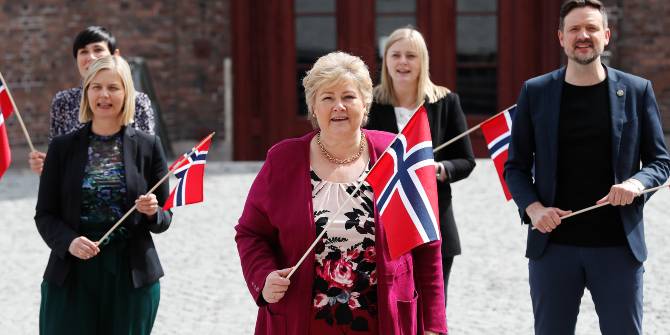Some countries have been better positioned to limit the spread of COVID-19 than others. Roosa Tikkanen, Ana Djordjevic, Reginald D Williams II (Commonwealth Fund) and George A Wharton and Elias Mossialos (LSE) introduce the 2020 International Profiles of Health Care Systems, which help to understand how 20 countries, including Germany, Norway and Taiwan, have made decisions about health care.
For a decade, the Commonwealth Fund and the London School of Economics and Political Science have collaborated to produce the International Profiles of Health Care Systems, which show how health systems across the world are organised. The 2020 profiles — released last week — feature 20 countries across North and South America, Europe, Asia, and Australasia. While the profiles do not directly address pandemic preparedness, they do offer context for understanding how countries have responded to COVID-19. The profiles describe how decisions regarding health care and public health are made — including for infectious disease control — at the national, regional, and local levels. This can help readers understand why some countries have been better positioned to monitor and limit the spread of the virus.
The profiles describe underlying governance and regulatory structures that have allowed countries to provide affordable care for infectious diseases, tracking the spread of the disease and maintaining access to essential services. Highlights include:
• Eliminating cost barriers in Norway. In Norway, according to national law, all individuals are exempt from cost-sharing for visits, tests, and treatments for infectious diseases deemed to pose a public health threat. The novel coronavirus (SARS-CoV-2) that causes COVID-19 was swiftly added to this list in January, joining other respiratory viruses that caused previous outbreaks around the world such as SARS and MERS. Doing so lowers barriers to care and encourages people to seek diagnosis and treatment early, which allows containment measures like home quarantine to be put into place in a timely manner.

• Centralised and integrated electronic patient databases in Taiwan. In Taiwan, all residents have a national health insurance card that allows health providers to access their medical information, including visits, prescriptions, and vaccinations. During the COVID-19 pandemic, the Taiwanese government used information from this database to seek out patients with severe respiratory symptoms who had tested negative for the flu. It then retested them for COVID-19. Such a tool can help countries identify and track infectious disease outbreaks quickly.
• Rapid regulatory changes to maintain access to essential services in Germany. Germany’s health care system is known for its structure of independent, self-governing bodies responsible for health care decisions. The highest decision-making body is the Federal Joint Committee, which includes members from sickness funds (i.e., insurers), providers, and patients. In March, the country’s infectious disease control agency raised the COVID-19 epidemic risk level to “high.” Soon thereafter, the Federal Joint Committee moved to ease regulations in the ambulatory care sector, introducing temporary measures to allow physicians to offer video consultations, issue or renew prescriptions, and generate referrals and sick notes for employers electronically or by phone. These measures helped maintain access to essential services and safeguard providers and patients from potential exposure to the virus.
The COVID-19 pandemic has forced health systems around the world to adapt radically — and rapidly. All countries have increased their capacity for testing, tracing, and isolating cases to identify and contain local outbreaks. Others have moved to centralise certain functions for monitoring and limiting the spread of the virus, such as the purchase of personal protective equipment, or sharing resources like medical personnel, hospital beds, and ventilators across regions. Countries’ ability to adapt is partly a function of their underlying policies and the structural capabilities in place before the crisis emerged, as showcased by the examples above.
Co-ordinated, global action is required to enable nations to work together to better prepare for — and prevent — future pandemics. There are several examples of countries collaborating across borders, for example, in joint purchasing and supply of tests and personal protective equipment. Perhaps most notably, there has been a globally concerted effort to expedite the development of a COVID-19 vaccine.
During the pandemic, many countries have suffered disruption in the provision of elective and ambulatory care. It remains to be seen how health systems may realign services to meet these potentially pent up or unmet needs while improving their ability to respond to future outbreaks, including potential future waves of COVID-19. In addition, the economic crisis resulting from lockdown measures will test the sustainability and resilience of health systems. Recovery efforts will build on countries’ underlying systems and structures; the profiles provide a primer on those systems.
As we move through and beyond this crisis, the profiles can be used as part of a broader analytical toolkit for understanding why the pandemic has had a disproportionate impact on some countries compared to others.
This post represents the views of the authors and not those of the COVID-19 blog, nor LSE.



Sou mestranda em administração pela PUC MG e estou fazendo uma pesquisa sobre as ações que o governo federal desenvolveu para combater a Covid 19. Podem me auxiliar nestas questões, por gentileza?
Agradeço.
Um abraço.
From one of the authors: “The question is about if we are investigating government actions to tackle COVID-19 in Brazil. That was not part of this initiative, but our document helps to understand the strengths and weaknesses of the Brazilian health system to face the pandemic. To get more information, you can look for publications on the Brazilian Ministry of Health’s website.“